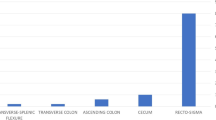Abstract
Purpose
Colonoscopy is currently a standard and widespread technique used in screening for colorectal cancer. Iatrogenic colonic perforation during colonoscopy is an unfortunate complication that can induce significant morbidity and even death. Here, we reviewed the clinical results of iatrogenic colonoscopic perforation in our hospital.
Methods
This was a retrospective review of 35,186 colonoscopies performed in the Tri-Service General Hospital, Taipei, Taiwan from January 1998 to December 2007. Patient demographic data, indications, comorbidities, operative history, perforation site, time of diagnosis, management, complications, hospital stay, and outcomes were recorded.
Results
In this 10-year period, 23 cases of iatrogenic colonic perforation were recorded (0.065%) affecting 11 men and 12 women. The mean age was 71.2 years. There were 13 patients in American Society of Anesthesiology (ASA) classifications 1 or 2 (low anesthetic risk, group A), and ten patients in ASA classes 3 or 4 (high anesthetic risk, group B). The mean hospital stay was 12 days in group A versus 23.5 days in group B (P = 0.002). Moreover, four patients in group B died (17%; P = 0.024).
Conclusion
Colonoscopy-related perforation can progress to peritonitis and sepsis, resulting in serious morbidity or death. High-anesthetic risk patients with colonic perforation have a longer hospital stay and a poor prognosis. Hence, patients need to be informed of the complications of colonoscopy, and clinicians must be cautioned about the potential problems for patients with a high-anesthetic risk when performing the procedure.

Similar content being viewed by others
References
Wolff WI, Shinya H (1971) Colonofiberoscopy. JAMA 217:1509–1512
Avgerinos DV, Llaguna OH, Lo AY et al (2008) Evolving management of colonoscopic perforations. J Gastrointest Surg 12:1783–1789
Lüning TH, Keemers-Gels ME, Barendregt WB et al (2007) Colonoscopic perforations: a review of 30,366 patients. Surg Endosc 21:994–997
Rex DK, Bond JH, Winawer S et al (2002) Quality in the technical performance of colonoscopy and the continuous quality improvement process for colonoscopy: recommendations of the U.S. Multisociety Task Force on Colorectal Cancer. Am J Gastroenterol 97:1296–308
Rumstadt B, Schilling D (2008) Optimizing time management after perforation by colonoscopy results in better outcome for the patients. Hepatogastroenterology 55:1308–1310
Anderson ML, Pasha TM, Leighton JA (2000) Endoscopic perforation of the colon: lessons from a 10-year study. Am J Gastroenterol 95:3418–3422
Caprio G, Albu E, Gumbs MA et al (1989) Management of colonic perforation after colonoscopy: report of three cases. Dis Colon Rectum 32:624–626
Ker TS, Wasserberg N, Beart RW Jr (2004) Colonoscopic perforation and bleeding of the colon can be treated safely without surgery. Am Surg 70:922–924
Orsoni P, Berdah S, Verrier C et al (1997) Colonic perforation due to colonoscopy: a retrospective study of 48 cases. Endoscopy 29:160–164
García Martínez MT, Ruano Poblador A, Galán Raposo L et al (2007) Perforation after colonoscopy: our 16-year experience. Rev Esp Enferm Dig 99:588–592
Hall C, Dorricott NJ, Donovan IA et al (1991) Colon perforation during colonoscopy: surgical versus conservative management. Br J Surg 78:542–544
Author information
Authors and Affiliations
Corresponding author
Additional information
This article has no support of commercial associations (e.g., consultancies, stock ownership, equity interests, patent-licensing arrangements, etc.).
Contributors
Chia-Cheng Wen and Kuo-Feng Hsu—contribution to collect the data
Shu-Hui Wen—contribution to statistical analysis
Chang-Chieh Wu—contribution to the design the methods of the study
Shu-Wen Jao—contribution to analyze the result and discussion
Cheng-Wen Hsiao—the leader of this study
Rights and permissions
About this article
Cite this article
Mai, CM., Wen, CC., Wen, SH. et al. Iatrogenic colonic perforation by colonoscopy: a fatal complication for patients with a high anesthetic risk. Int J Colorectal Dis 25, 449–454 (2010). https://doi.org/10.1007/s00384-009-0822-z
Accepted:
Published:
Issue Date:
DOI: https://doi.org/10.1007/s00384-009-0822-z




